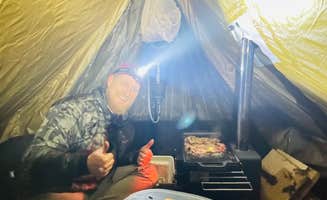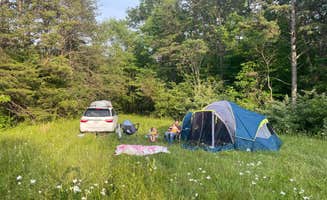Dispersed camping near Jamestown, Kentucky offers rustic outdoor experiences within Daniel Boone National Forest and surrounding public lands. These primitive campsites require self-sufficiency with temperatures ranging from 25°F in winter to 85°F in summer. The region sits at elevations between 723-1200 feet, creating diverse terrain for backcountry camping options ranging from riverside spots to ridge overlooks.
What to do
Fishing access: Trace Branch Dispersed camping area provides direct access to Rock Creek. "One picnic table and fire pit. Dispersed camping. We took our portable firepit and sat by the creek for a beautiful evening," notes camper Pam B. about the Trace Branch site.
Stargazing opportunities: The minimal light pollution makes this area excellent for night sky viewing. A camper at Swain Ridge shares: "It was a beautiful, quiet pasture. We were even blessed with see several bats fly around at night. There was no light pollution so we had a great time star gazing!"
Boating access: Redbird Boat Ramp camping area provides direct access to water recreation. "Nothing special there is a boat ramp. Plenty of space for a couple RVs. No amenities. The sky was beautiful. Would go again. About ten miles off 75," reports camper Kody Bear A.
What campers like
Winter camping options: Some locations remain accessible year-round. "Visited here in the middle of January with all the snow and I was hot tent camping. You can only set up your tent on the designated tent pad, luckily we had heavy duty stakes that could get through the ground. The entire river was frozen over and ponds were frozen too," shares Matthew H. about Redbird Boat Ramp.
Privacy and solitude: The dispersed nature of these sites provides isolation from other campers. "It was wonderfully secluded, we used the car to 'mow' the grass down, and set up fine," reports Sierra E. from her stay at Swain Ridge.
Wildlife viewing: The natural setting offers opportunities to observe local wildlife. Multiple campers report sightings of bats, birds, and small mammals, especially during dawn and dusk hours.
What you should know
Strict camping regulations: Some areas have specific rules about where camping is permitted. "Not able to camp in open field. 1000$ fine for doing so. Camping at trailhead or on road side is fine," warns Jacob M. about Swain Ridge.
Potential for insects: Ticks and other pests can be prevalent, especially in warmer months. Sierra E. notes: "But we did have ticks EVERYWHERE and poison ivy along the edges of the pasture. We had a ball we were playing with roll in there."
Limited facilities: All sites lack basic amenities. Aaron R. succinctly describes Redbird Boat Ramp: "It's a boat ramp," highlighting the minimal infrastructure available at most rustic camping areas near Jamestown.
Tips for camping with families
Site security considerations: Despite the remote nature, some campers report feeling secure at these locations. Matthew H. shares: "There were a few cars that drove through the middle of the night but no issues. We left our site unattended for hours to check out the streams and rivers and nothing was missing."
Pack heavy-duty tent stakes: The ground at some sites can be compacted, especially at designated tent pads. Bring appropriate gear for securing tents in various ground conditions.
Be prepared for trash cleanup: Some areas may have litter left by previous visitors. "Lots of beer bottles left over and shattered so I had to pick up the trash before letting my dog out," notes one visitor at Trace Branch Dispersed.
Tips from RVers
Space limitations: While some areas accommodate RVs, space is limited. "Plenty of space for a couple RVs," notes a camper at Redbird Boat Ramp, but larger rigs may struggle with access.
Road conditions: Access roads are typically unpaved and can become problematic in wet weather. Campers recommend checking recent weather conditions before attempting access with larger vehicles.
Site selection strategy: For the best spots, experienced campers recommend arriving early. "There are more sites down the gravel road but we went with the first one we came to," explains one Trace Branch visitor, suggesting that earlier sites may be preferable.



